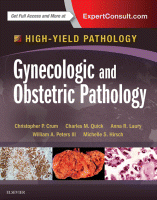Physical Address
304 North Cardinal St.
Dorchester Center, MA 02124

D efinition — An increase in thickness of the epithelial layer, occasionally forming papillary tufts within the tubal lumen. Clinical Features Epidemiology Papillary hyperplasia is an uncommon entity, and no associations have been made regarding incidence or predisposing factors. They…

D efinition — A serous intraepithelial neoplasm of uncertain risk that does not fulfill the criteria for serous tubal intraepithelial carcinoma (STIC). Clinical Features Epidemiology Low-grade serous tubal intraepithelial neoplasia (STIN) is synonymous with a proliferation produced when there are…

D efinition — A limited clonal expansion of secretory cells associated with mutations in p53 exhibiting minimal or atypia. Seen as perhaps the very first step in serous carcinogenesis in the tube; often termed a “latent precursor” to pelvic serous…

D efinition — Benign, self-limited clonal proliferations of tubal secretory-type cells with variable ciliation. Clinical Features Epidemiology and Pathogenesis Secretory cell outgrowths (SCOUTs) are common proliferations seen most commonly in the sixth and seventh decades of life but may be…

D efinition — A benign neoplasm of the distal tube. Clinical Features Epidemiology Adenofibromas are thought to be relatively common entities within the fallopian tube and are found predominantly within the fimbriated end of the tube. You’re Reading a Preview…

PITFALL D efinition — Hormonally induced changes that occur within the epithelium of the gynecologic tract (typically secondary to pregnancy). Clinical Features Epidemiology Arias-Stella effect is most commonly seen in the background of pregnancy; however, it can be seen in…

D efinition — Mechanical interruption of the adnexal arterial and/or venous blood flow by mechanical factors. Clinical Features Epidemiology Rare (reported in as few as 1 in every 1.5 million women), can occur at any age but usually in reproductive-age…

D efinition — Granulomatous inflammation of the fallopian tube. Clinical Features Epidemiology Granulomatous salpingitis is uncommon. The granulomatous inflammation may be secondary to infectious causes ( Mycobacterium tuberculosis , actinomyces, and parasitic infections) or noninfectious causes (sarcoid, Crohn's disease, or…

D efinition — A proliferation of smooth muscle with accompanying epithelium in the fallopian tube, analogous to adenomyosis/adenomyoma seen within the uterus. Clinical Features Epidemiology Salpingitis isthmica nodosum (SIN) is a relatively common phenomenon seen in up to 11% of…

D efinition — The chronic phase of pelvic inflammatory disease. Clinical Features Epidemiology Follicular salpingitis is the chronic phase of pelvic inflammatory disease, which is common in the United States (as well as the remainder of the world). The majority…